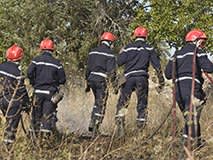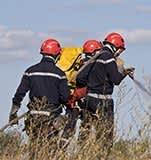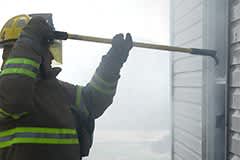Arson Investigation Training & Degree Programs
Basic or advanced arson investigation training programs leading to certifications may be completed in less than a year. Workshops or intensive training programs can accelerate skills training in less than two weeks. You’ll find a great variety of programs that focus on origin-and cause-investigative skills that combine research methods, field work, classroom lectures and even online modules.

Coursework is made up of theoretical as well as practical applications of science in tracing fire or explosive origins and materials. You learn how to use IT tools to compile data, develop case management skills, and how to preserve expert evidence. There are additional classes in fire science, burn-pattern tracking, electrical and ignitable liquids characteristics.
Arson investigators must develop skills to work in fire task forces, coordinating their efforts with fire marshals, law enforcement personnel, the district attorney staff, and criminal investigators. You’ll need to know how to interview witnesses or involved parties, hold follow-up investigations, and how prepare and deliver testimony. Some departments authorize the use of K-9s in tracing fire causes and conditions, requiring additional canine handling training for their arson investigators.
Careers in Arson Investigation
Turn on any television and you’ll find popular law enforcement and criminal investigations dramas. Agents from federal, state and local law enforcement agencies often conduct comprehensive fire scene inquiries to determine whether a crime was committed. Since cause and blame are often intertwined, insurance companies and private agencies also hire qualified arson investigators on a regular basis. It takes intensive training, a thirst for solving problems, and fire department experience to become an arson investigator.

There are several pathways into the profession. You may combine a high school diploma and volunteer fire department experience to qualify for entry level jobs. Many state and local fire and law enforcement agencies send new recruits to their own comprehensive training programs. Post-secondary arson investigation training programs can also provide a foundation in the field for firefighters seeking advancement into forensics study.
Federal investigative bodies, including the Bureau of Alcohol, Tobacco and Firearms and Explosives (A.T.F.) partner with the International Association of Arson Investigators (I.A.A.I.)to develop short-tern training and certification programs. The insurance industry also offers a route into the field. It sends selected candidates to IAAI / ATF Advanced Arson Training Programs.
Understanding Arson Basics
As an arson investigator, you’ll need to gather proof of willful incendiarism. Fires leave behind shadows, cone-shaped burns, v-shaped flow patterns, and telltale smoke damage. Firefighters who first arrived at the scene should be interviewed since the fire can subsequently eliminate evidence, as can fire-suppression foam or water. Witnesses and firefighters can identify the color of the smoke before the fire was battled, helping arson investigators determine materials or chemicals involved in the blaze.
Was the building secure at the time of the fire or was there a break-in? Is there a financial motive that could be at the center of the suspected crime? Who placed the initial fire call to authorities? Arson investigators measure the building and map the rooms, windows and doors. You’ll determine where owner or occupants were at the time the fire started.
If the building was outfitted with fire alarms, sprinklers or other suppression systems, did these work at the time of the fire? Were they turned off or otherwise compromised? Was there a history of personal problems among the residents/employees that might reveal a motive for revenge? If the building is a residence, were sentimental personal affects and photos removed before the fire?
If there is a death as a result of the fire, then the investigation may be jointly conducted by police and fire teams. The arson investigator may have to document the location of bodies, take photographs, and work with the medical examiner. As a fire department employee you may need to work directly with insurance representatives. The Arson Immunity laws of the states allow insurance companies to share policy holder records with fire and police agencies when they suspect arson is involved.
In some cases, you may be called upon to examine the history of building ownership and mortgage records. You may tram up with a forensic accountant to pore over bank records, tax returns, and other business documents for delinquency or conflicting figures.
Arson Investigation Career Outlook
The U.S. Bureau of Labor Statistics (BLS) predicts that jobs for fire inspectors and investigators will increase by nine percent from 2010 to 2020. More than 70 percent of fire investigators are employed by local governmental agencies, with another 18 percent taking jobs with state governmental agencies. The balance works in the insurance sector.

As a qualified arson investigator you’ll need a sharp eye, dedicated commitment to discovering the truth, and the professional integrity to follow your findings through the legal system. Arson investigation training programs can open doors to this exciting field where you can make a difference.







